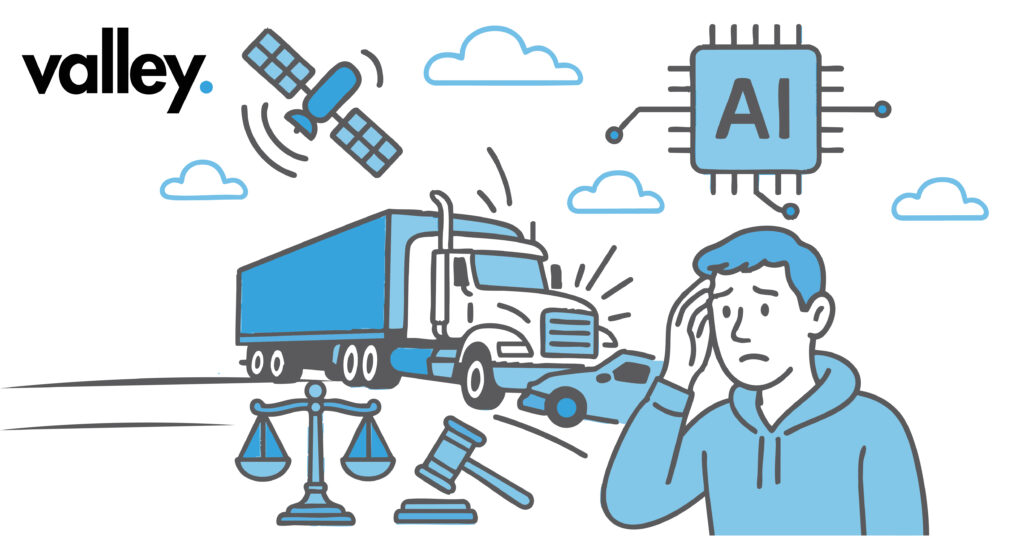AI in Trucking Accidents: Will Fleets or Insurers Take the Fall?

Artificial intelligence is transforming how trucking companies operate, from safety monitoring to driver assistance systems. But with every new sensor, algorithm, and automation feature, one question is becoming harder to answer: who takes the blame when an AI-assisted truck crashes?
As AI takes a bigger role in preventing accidents and recording what happens on the road, the issue of fault is no longer simple. Fleets, insurers, and manufacturers now share risks that used to fall on one party alone.
Quick Answer
When AI contributes to a trucking accident, liability can shift between the driver, the fleet, the manufacturer, and even the software developer. Insurers are rewriting policies to address these gray areas, but coverage gaps still exist. Fleets that do not maintain or document their AI systems properly could be held responsible even when the driver is not at fault.
Why This Issue Matters
Trucking accidents are costly and complex, and AI systems are changing how they are investigated. The Federal Motor Carrier Safety Administration reports that crashes involving large trucks cause thousands of deaths each year and cost the industry billions. Safety technology such as collision avoidance, lane departure alerts, and adaptive cruise control is designed to lower those numbers.
But when AI systems malfunction, investigators have to examine not only what the driver did but also what the system decided and why. According to Reuters, similar questions are already appearing in autonomous vehicle cases, where insurers are still defining how to handle claims that involve algorithms.
Meanwhile, Insurance Journal reports that insurers are now hiring AI and data experts to review system behavior and logs after accidents. Claims teams that used to rely on driver statements now need engineers to interpret system decisions and data records.
How AI Is Changing Liability in Trucking
Shared Responsibility
In traditional accidents, the driver and the carrier are usually responsible. With AI systems in the mix, accountability can involve several different parties.
- Fleet operators for system maintenance, calibration, and updates
- Manufacturers for hardware or software defects
- Technology vendors for faulty sensors or configuration errors
- Drivers for ignoring alerts or failing to intervene
- Insurers for outdated policy wording that excludes new risks
This shared responsibility means fleets must keep strong documentation and work closely with their insurance partners to stay protected.
Data as the New Evidence
Crash investigations no longer rely only on photos or eyewitness accounts. AI-equipped trucks store event data, sensor logs, and video footage that show every move the system made. Fleets must ensure they have access to this data after an accident, otherwise they may lose the ability to defend against claims.
Policy Gaps and Coverage Confusion
Many trucking policies were written before AI systems became common. Some exclude electronic or software malfunctions, leaving fleets exposed when technology fails. Both fleets and insurers need to update contracts and policies to define who is responsible when AI contributes to a crash.
Real-World Scenarios
- Sensor Misread: A truck’s radar system misinterprets a stopped vehicle and brakes suddenly, causing a rear-end collision. The fleet blames the manufacturer, but investigators find maintenance logs incomplete. Liability shifts back to the fleet.
- System Override: A driver disables lane-keeping alerts after repeated false alarms. A sideswipe occurs shortly after, and the insurer argues that disabling the system voided coverage. The claim turns into a shared liability case.
- Data Dispute: After a crash involving AI braking, the manufacturer refuses to release system logs, claiming proprietary control. Without the logs, the insurer and fleet cannot determine if the system failed or if human error was involved.
The Impact on Fleets
- Stricter Oversight: Fleets must treat AI tools as core safety equipment and maintain consistent update schedules.
- Higher Accountability: Poor documentation or delayed updates can shift fault to the company, even if drivers were careful.
- Longer Claims Process: Cases involving AI require technical analysis and expert reviews, which extend investigation times.
- Training Demands: Drivers must be taught how to interpret system alerts and when to take manual control.
- Reputation Risks: Fleets that cannot produce AI maintenance and data records may lose client and insurer trust.
The Impact on Insurers
- Complex Claims: Determining liability now involves engineers, software experts, and data analysts.
- Policy Redesign: Insurers are starting to merge traditional auto, product, and cyber coverage to handle AI risk.
- Data Dependencies: Insurers may need direct access to event data recorders to validate claims quickly.
- Premium Adjustments: Fleets that maintain detailed AI compliance records could qualify for better rates.
How Fleets and Insurers Can Respond
- Align Contracts and Policies: Review vendor agreements and insurance documents to ensure AI-related incidents are covered.
- Secure Data Access: Make sure fleets and insurers can retrieve AI logs, camera footage, and system reports after accidents.
- Document Everything: Keep thorough records of updates, calibrations, inspections, and driver training sessions.
- Provide AI-Specific Training: Help drivers and claims staff understand how systems behave and what to do when they fail.
- Collaborate with Partners: Fleets, insurers, and technology providers should share data and best practices to reduce confusion during claims.
FAQs
What happens if an AI system makes a mistake?
- Liability may involve both the fleet and the manufacturer, depending on whether the issue was caused by poor maintenance or a design flaw.
Can insurers deny AI-related claims?
- Yes. If policy exclusions apply or if the fleet ignored required updates or maintenance, a claim can be rejected.
Who owns the data from AI-equipped trucks?
- Ownership depends on the agreement between the fleet, manufacturer, and software vendor. Fleets should negotiate full data access before deployment.
Does AI reduce trucking accidents?
- Yes, when used and maintained properly. Studies show lower crash rates in fleets that adopt AI-powered safety systems.
Will fleets without AI face higher premiums?
- Possibly. As AI becomes the industry standard, fleets without automation may be seen as higher-risk operators.
Final Thoughts
AI is reshaping the trucking industry, not just in how trucks move, but in how responsibility is shared when things go wrong. The line between human and machine error is blurring, and that means fleets and insurers must evolve together.
Fleets that keep clear records, maintain open access to data, and train their teams will adapt smoothly. Insurers that update their policies and embrace collaboration with technology providers will build trust and stability. AI does not eliminate risk; it changes where that risk lives. Understanding that shift will help both sides stay protected on the road ahead.
